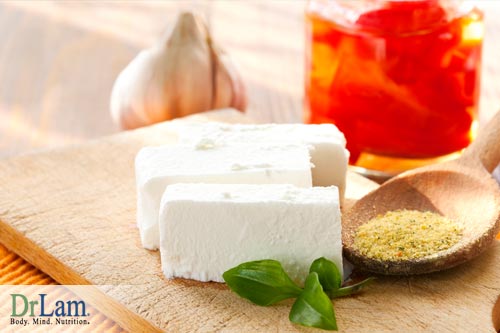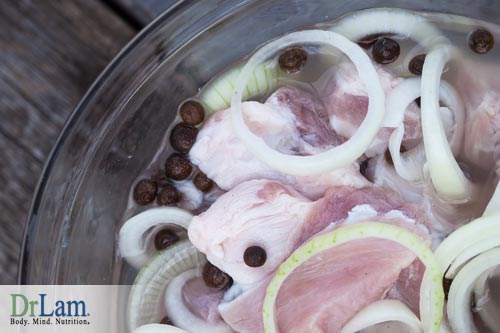 Cooking with high temperatures and dry heat causes an increase in certain dangerous compounds, or advanced glycation end products (AGEs). AGEs that we consume, also called dietary AGEs (dAGEs), can lead to inflammation and oxidative stress, resulting in a variety of health problems. This article provides more details on dAGEs, how they are tested, analyzes cooking methods and their effects, and how to limit our daily intake of dAGEs.
Cooking with high temperatures and dry heat causes an increase in certain dangerous compounds, or advanced glycation end products (AGEs). AGEs that we consume, also called dietary AGEs (dAGEs), can lead to inflammation and oxidative stress, resulting in a variety of health problems. This article provides more details on dAGEs, how they are tested, analyzes cooking methods and their effects, and how to limit our daily intake of dAGEs.
Cooking with low moisture can increase dAGEs. In one study, dry heat created 10 to 100 times more dAGEs than if the product were left uncooked, regardless of the type of food was tested. Foods that contain high volumes of protein and fat, like those from an animal sources, are the usual culprits for the creation of new advanced glycation end products when cooked. Even the uncooked forms of many animal products contain AGEs, and this number increases even more when the foods are cooked. This is especially true when using high-temperature methods for cooking such as frying, roasting, grilling, searing, and broiling.
Carbohydrate-rich foods, on the other hand, including fruits, vegetables, milk, and whole grains, contain low amounts of AGEs. Even when these foods are cooked, they still contain fewer AGEs. Decreased cooking times, using moisture while cooking, the use of lower temperatures, and the addition of acidic marinades like vinegar, help to prevent the formation of new dAGEs.
Advanced glycation end products (AGEs), also known as glycotoxins, play a role in many chronic illnesses through causing oxidative stress. Oxidative stress occurs when oxygen, which is released when normal chemical reactions occur in the body, steadily accumulates and is not eliminated by antioxidants. With this gradual oxygen build-up, chronic inflammation occurs, damaging bodily tissues. AGEs create oxidative stress when sugars are paired with protein or fat through the browning of food, known as the Maillard reaction. Though advanced glycation end productsare actually created naturally through our metabolic processes, damage occurs when high levels exist in the body. AGEs bind with cell receptors or proteins in the body, which can change their shape and function. Types of AGEs include the secure and unmoving carboxymethyllysine (CML) and the very reactive methyl-glyoxal (MG).
When it comes to our body reacting to stress, the neuroendocrine system plays the biggest role through the HPA (hypothalamic pituitary adrenal) hormonal axis. Stress is received in the brain, where it is processed and action is assigned to a specific organ or area through chemical messengers. One of the most targeted organs is the adrenal glands, which sit on top of our kidneys. These small glands excrete more than 50 hormones that fight stress – the most important of these is cortisol. Cortisol is important to the body and because it helps maintain normal levels of blood sugar, immune system function, blood vessels, and inflammation. When chronic stress is put on the body, the HPA axis and cortisol levels are greatly affected and overwhelmed. This can lead to adrenal fatigue, which consists of four stages.
 The first stage of adrenal fatigue, also known as early fatigue, occurs when the body ramps up efforts to reduce stress and shows little symptoms. Stage two is defined by decreasing cortisol levels, because the adrenal glands are not able to keep up, leading to a feeling of fatigue. In stages three (adrenal exhaustion) and four (adrenal failure), symptoms become so much that the person may become bedridden and fatality can occur if the condition is not corrected.
The first stage of adrenal fatigue, also known as early fatigue, occurs when the body ramps up efforts to reduce stress and shows little symptoms. Stage two is defined by decreasing cortisol levels, because the adrenal glands are not able to keep up, leading to a feeling of fatigue. In stages three (adrenal exhaustion) and four (adrenal failure), symptoms become so much that the person may become bedridden and fatality can occur if the condition is not corrected.
The body’s automatic way of shielding itself from damage caused by stress is called the NeuroEndoMetabolic (NEM) Stress Response system. The NEM incorporates several systems and organs to fight against stress, which is represented in six ways: hormonal, metabolic, neuro-affective (central and autonomic nervous systems), cardionomic (lungs, heart, vessels), inflammatory, and detoxification. When stress becomes too much, the body’s ability to automatically combat it through the above defense mechanisms is compromised. When any one system is disrupted in its normal functional capacity to deal with stress, as is seen with high levels of dAGEs and adrenal fatigue, it eventually affects all systems because they are interconnected. An increased consumption of dAGEs creates oxidative damage, affecting all these other systems and disrupting how the body deals with stress, eventually leading to adrenal fatigue.
Today’s diets have been proven to contain high amounts of advanced glycation end products. It was once thought that the body predominantly passed through dAGEs. Now, however, evidence from both human and mice studies show that the body does absorb these dietary AGEs, and they negatively affect the aging process and chronic health conditions. When mice were fed a diet high in advanced glycation end products, they developed hardening of the arteries as well as kidney disease. When dAGEs were restricted in a mouse population, the risk for type 1 and 2 diabetes decreased, kidney and vascular function improved, and wounds healed faster. In fact, restricting dAGEs led to a longer life in mice. In human studies, increased dietary AGEs heightened inflammation and oxidative markers in the blood. When dAGEs were limited, these markers decreased, both in healthy participants and in people with kidney disease or diabetes.
Nearly 250 foods have been tested for dAGEs, but there is much more research to be done in this area. A recent study expanded the library of foods tested, showed the best methods of testing for advanced glycation end products, investigated methods of testing of new dAGEs, and found ways to reduce the consumption of dAGEs. This study used the typical food and diet of New Yorkers, as well as their predominant method of cooking and the estimated temperature (broiling 437°F, baking 446°F, boiling 212°F, roasting 350°F, and deep-frying 446°F). This research found the concentration of AGEs within 549 foods, ranked by CML content. Meat topped the list with the highest amount of AGEs. Even though fat usually provides more dAGEs per gram compared to that of protein, meat is typically given in bigger servings than fats. Beef and cheese also ranked high, followed by poultry, pork, fish, and eggs. Even lean cuts of poultry or red meat had elevated dAGEs when cooked using low moisture and high temperatures.
 Types of low-fat cheese contained less dAGEs than high-fat and aged cheeses. In general, even uncooked animal-sourced foods like cheese had high amounts of dAGEs. Foods such as cream cheese, butter, mayonnaise, and margarine also contained a lot of dAGEs due to their fat content, unlike nuts and oils. Eggs that were scrambled and cooked with oil, margarine, or cooking spray had anywhere from 50% to 75% fewer dAGEs than when prepared using butter. Among carbohydrate-rich foods, chips, crackers, and cookies topped the list since they are highly processed using dry heat. Legumes, whole grains, breads, fruits, vegetables, and milk ranked lowest in dAGEs. Milk with lower fat content had far fewer dAGEs compared with whole milk.
Types of low-fat cheese contained less dAGEs than high-fat and aged cheeses. In general, even uncooked animal-sourced foods like cheese had high amounts of dAGEs. Foods such as cream cheese, butter, mayonnaise, and margarine also contained a lot of dAGEs due to their fat content, unlike nuts and oils. Eggs that were scrambled and cooked with oil, margarine, or cooking spray had anywhere from 50% to 75% fewer dAGEs than when prepared using butter. Among carbohydrate-rich foods, chips, crackers, and cookies topped the list since they are highly processed using dry heat. Legumes, whole grains, breads, fruits, vegetables, and milk ranked lowest in dAGEs. Milk with lower fat content had far fewer dAGEs compared with whole milk.
The content of AGEs in food can be determined by the amount of CML (carboxymethyllysine) and MG (methyl-glyoxalbyproducts). This same study has shown that although MG and CML differ structurally, they show correlations that allow researchers to continue to use CML as a functional marker for the concentration of dAGEs. To test for AGE concentration, food samples must be homogenized and tested with chemical assays. Researchers are currently working on a simpler testing method that includes an LED-light scanner to measure AGE levels.
Although research is emerging on this topic, the amount of dAGEs consumed by the average person is not well known. Recently, a study found that among a healthy population in New York, participants ate around 15,000 AGE kU/day. For people who typically consume vast amounts of grilled or baked meats, processed foods, or foods high in fat, their diet could prove to be around 20,000 kU/day. On the other hand, someone who frequently consumes foods like soup, small amounts of meat, and lots of vegetables could be on the lower end of the spectrum when it comes to dAGEs consumption. However, an optimal dAGE recommendation for prime health is yet to be determined. What is known is that among animals, oxidant stress, insulin, and kidney function improve and life is prolonged when dAGEs are reduced by half.
The way in which we cook our food matters. Research shows that the cooking method alone can greatly affect the dAGEs produced. One study showed that eggs scrambled in an open pan on high heat, compared to eggs that were scrambled on low to medium heat, doubled the amount of dAGEs. Similarly, when chicken was baked or broiled instead of steamed or poached, the amount of dAGEs increased 75%. All foods contained less dAGEs when cooked using lower temperatures and higher moisture levels, such as poaching, boiling, stewing, or steaming. High temperature and low moisture cooking methods producing higher amounts of dAGEs include broiling, grilling, baking, frying, and roasting. Using the microwave to cook foods (for less than six minutes) did not increase dAGE concentration like the dry heat techniques mentioned above.
A medicine called aminoguanidine, used among diabetics for nephropathy, was found to completely block the formation of new advanced glycation end products. Marinades, especially acidic liquids such as vinegar or lemon juice, actually inhibit new AGE formation. Research shows that when these liquids were used to marinate beef for one hour, there was a dAGE reduction of 50% as compared with non-altered meat.
There are several simple things we can do to decrease our dAGEs.
Eating more fruits, vegetables, grains, low-fat milk, and legumes can help, as they naturally contain fewer AGEs than foods that are animal-sourced like meat and cheese.
 Using a marinade inhibits the formation of new dAGEs in our food. When an acidic marinade was added, like vinegar and lemon juice, dAGEs were cut in half. Try to let your meat soak before cooking.
Using a marinade inhibits the formation of new dAGEs in our food. When an acidic marinade was added, like vinegar and lemon juice, dAGEs were cut in half. Try to let your meat soak before cooking.
High and dry heat produce many more AGEs than moist and low heat, so try poaching or using a slow cooker to prepare your meals. AGEs can be reduced by about 75% when using a method like steaming instead of broiling.
The microwave is also a good option, as it similarly proved to produce fewer advanced glycation end products than dry heat techniques.
Making your own recipes from scratch can help as well since processed foods contain more advanced glycation end products.
Reducing our dAGE consumption has been shown to have a positive effect on many areas, such as the heart, kidney, insulin sensitivity, and inflammation. The benefits can also be seen on a whole body and homeopathic level. The body only well works when all of its systems work together. Just as in the case of adrenal fatigue, a succession of systems in the body can breakdown when the stress on any one system becomes too much and the body cannot cope. By reducing our AGE consumption, we limit oxidative damage and prevent tissue damage, as well as inflammation, which is one of the key components to adrenal fatigue. AGEs in our diet affect not just one area, but the body as a whole. Limiting their consumption by selecting foods that are naturally low in AGEs, and cooking foods with low heat, lots of moisture, and acidic marinades will allow our bodies to function properly on every level and help those with adrenal fatigue on their road to recovery.
It isn't just heavily processed foods that can be dangerous to your health. Even healthy foods can be bad for you when the wrong cooking methods are used, creating dangerous compounds known as advanced glycation end products. If you're looking to remove these health threats from your diet as much as possible, here's how to start:
Staying healthy can be complicated and avoiding all the world's health threats even more so. If you want help and support for your health journey, contact our team by clicking here or give us a call on +1 (626) 571-1234.
© Copyright 2016-2020 Michael Lam, M.D. All Rights Reserved.
